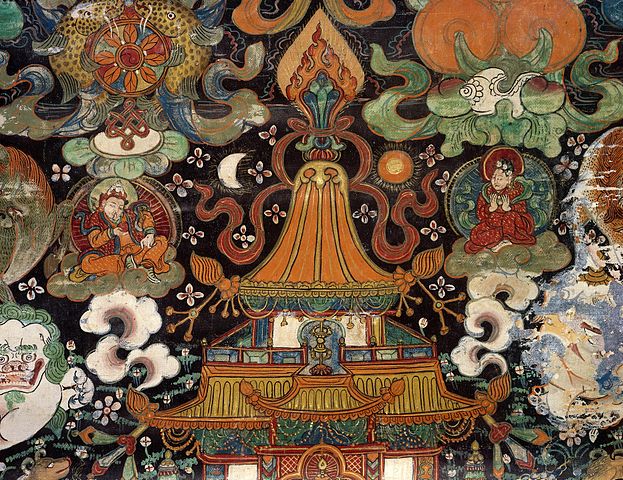Violent Buddhism, Bob Ross’s Missing Paintings, and Shakespeare’s Lost London Home

Let’s start this Monday off with a couple of Shakespeare items. Nick Smurthwaite writes about the search for one of Shakespeare’s London homes and what it might tell us about the man and his work: “‘Everything we know about Shakespeare’s life has been picked over ad nauseam, but curiously little has been written about the tax document from the parish of St Helen’s, which lists 49 people who were rich enough to pay this wealth tax. The richest person in the parish was Sir John Spencer, a one-time lord mayor of London, who was valued at £300. while Shakespeare is valued at £5.’ Marsh believes that what attracted the playwright to St Helen’s Place was its reputation as a fashionable enclave where he would be mixing with men of influence, wealth and education. He says: ‘If you accept that he lived in St Helen’s Place, he would have known these people. At that time everyone was expected to attend church – you were fined if you did not – and so Shakespeare would have met his neighbours there. Basically, he was a provincial boy from Stratford-upon-Avon who wanted to be considered a success in a very competitive environment.’ Undoubtedly, the most intriguing aspect of Marsh’s research is the conclusion he reached about the possible influence of Shakespeare’s neighbours on the plays he was writing at the time, which included Romeo and Juliet, The Merchant of Venice and Macbeth.”
Micah Meadowcroft reviews the Shakespeare Theatre Company’s production of Hamlet: “Let’s get the basics out of the way. Hamlet is one of the greatest plays in history. The Shakespeare Theatre Company is a celebrated professional troupe. The Free for All series makes world-class theater accessible to everyone, free to anyone willing to spend the time. It’s good! Residents of the DMV, citizens of the states, tourists from the imperial provinces, go see it before July 21. It is time well spent. As for the rest of it: The thing the play is—what’s the matter with Hamlet—is a vivisecting of authenticity.”
Bob Ross painting over 1,000 landscapes. Where are they now?
The sounds of a seven-foot gong.
Scott Beauchamp reviews T. C. Boyle’s latest novel, Outside Looking In: “So many of his works—most, I would argue—focus on the particular ways in which small groups of Americans delude themselves in to believing they’ve discovered the secret to unlock paradise and the ways in which these fantasies unspool. His most recent work is no different. Outside Looking In is set in the early days of clinical psychological LSD experimentation at Harvard, with the infamous Timothy Leary playing the role of megalomaniacal ringleader. The history of Brook Farm echoes through Cambridge and, later in the book, Leary’s exclusive camp in Millbrook, New York. Only here instead of pietism we have psychology and academia. Instead of farming we have therapy. And instead of God we have LSD.”
The art of the swimming pool: “By suspending the normal rules of earth-bound weight and motion, swimming pools bend certain rules of mental operation too, presenting possibilities for divine transformation and fatal transgression.”
Essay of the Day:
Westerners think of Buddhism as a religion of peace. The Dalai Lama is a Gandhi-like proponent of nonviolence. An exhibition at the Rubin Museum of Art tells a different story:
“One of the most fascinating sections of the show, and of the catalog, deals with China’s last dynasty, the Qing (1644–1912), run by another nomadic people from the north, the Manchus. They, too, turned to Tibetan Buddhism for legitimacy and to bolster their military power with its spiritual authority.
“One way the Manchus accomplished this was by using Buddhist stories and images to mobilize the Mongol soldiers who fought for them. A particularly graphic picture in the exhibition depicts the story of the Shambhala (a legend that eventually morphed into the fantasy of Shangri-La). In its original form, this was an end-times tale that foretold a Buddhist king leading his soldiers out of a hidden redoubt to annihilate all heretics and nonbelievers—whom the Manchus, in their telling, equated with the Qing’s enemies.
“During a recent visit to the Rubin, I spoke with the show’s curator and editor of the catalog, Karl Debreczeny. He pointed out that, for many people in the West, Buddhism is completely divorced from its history. So many of the beliefs and rites have been stripped away in this view that many Westerners regard it purely as a philosophy, rather than a religion. As well-intentioned as this version of Buddhism might be, it is also a fantasy that places its practice on a higher moral and spiritual plane and erects an unbridgeable distance between us and its real, historical significance in Tibet.
“‘This exhibition tries to challenge the western romantic notion of Buddhism and Tibet,’ he said. ‘These rulers were not interested in mindfulness, meditation, and yoga mats; they wanted to know what this religion could do for the state. One of the objectives [of the show] is to peel away these blinders and recontextualize the art.’”
Photo: Ornans
Poem: James Matthew Wilson, “Sloth”
Receive Prufrock in your inbox every weekday morning. Subscribe here.
Comments